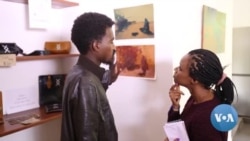The chaos of war surrounds the women in Sudanese artist Abubakr Moaz’s paintings.
“She’s sitting in here, confused and doesn’t know what to do,” Moaz said, describing on of them. “And there are gunshots around her. … She just left and [is] going nowhere, because she’s not able to live in her house anymore.”
It’s a scene Moaz knows from experience. He fled his home in Khartoum a few months after violence erupted there in April. He says he left everything behind, including his art studio. He first went through Ethiopia before landing in Kenya about a month ago.
“It was just tough days, really, really tough days,” he told VOA. “You needed to sleep outside in the streets for days, waiting for your bus, waiting for visas. Luckily … we had our passports with us.”
His work currently is part of an exhibit in the Kenyan capital, Nairobi, by a group of Sudanese artists.
Organizers called the pop-up exhibition, “Resilient Transitions,” an opportunity to create a space where all the Sudanese artists in exile can gather and meet others like themselves, said curator Rahiem Shadad.
“One of the main reasons why we did this event was to sort of bring in the Sudanese visual artists who came here due to the war and connect them one way or another to artists who are already in Nairobi, who have already created such a support system that have made this transition quite easy,” Shadad told VOA.
Once the director of Downtown Gallery in Khartoum, Shadad said that dealing with the trauma and displacement of war has been difficult.
“Most of us have lost a lot,” he said. “For example, for me, I lost a gallery, which hosted over 450 paintings inside of it.”
It’s been nearly five months since civil war erupted in Sudan between the Sudanese army and the paramilitary Rapid Support Forces, and there’s no end in sight. The U.N. Refugee Agency estimates that by year's end, 1.8 million people will flee to neighboring countries.
Event co-organizer Mohamed Elhassan is the director of 249 Arts and Culture in Sudan. He said the Nairobi event was a way to introduce artists to the local market and try to connect them to the world.
“What it means for us is basically to support these artists who had to flee the war and come here and restart from scratch,” Elhassan told VOA. “They lost their galleries. They lost their studios, even their … art that was there.
“For me, the most significant thing is for these artists to be able to produce again, for them to be able to break out of the trauma they face after the war … and be able to come up with all these great pieces you guys are seeing today,” he said.
Elhassan also said that Sudanese people have proven over the years that they are resilient and have always managed to find creativity out of chaos.
Tibian Bahari, a Sudanese artist who works with recycled material and construction waste as well as on canvas, has a painting, “Topography of Home,” in the exhibition.
She told VOA that the recent war has affected her and others in different ways.
“My painting has now significantly changed in terms of strength, in terms of contributing, in terms of I am also here,” she said. “I feel angry, and I am not really rushing into navigating that emotion of anger. I am actually more into dwelling into the question of what now? What can I do? How can I contribute as a diaspora? What is my responsibility as a diaspora, as an artist? … And most importantly, how am I documenting this time at a time when everything is being erased, everything is being disrupted.”
Ibrahim Ahmad, an award-winning Sudanese filmmaker who, like many, was displaced because of the war, said it was important to be at the event to connect with people that he used to know in Sudan, share knowledge with the new ones and together process the new realities.
And like many, he said he hadn’t expected the war to drag on for so long. That is one of the reasons that the only thing he took with him when he fled was his phone, he said.
“But I’ve lost everything,” he said, “because … everyone thought that it would end soon.”
Ahmad said that he has been building his filmmaking and video production business for the past five years, and that while it’s hard to put a value on everything he lost, the equipment he left behind was worth between $40,000 and $50,000.










